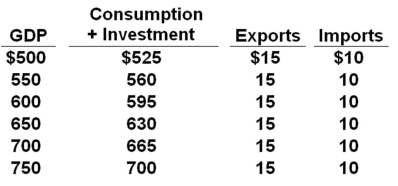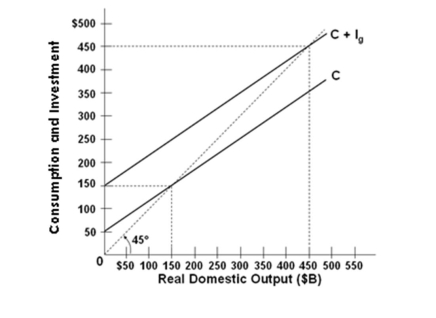A) All income is often spent in the same period of time
B) Oftentimes, people spend more than their incomes
C) The marginal propensity to spend out of additional income is quite volatile
D) Pessimism could cause aggregate spending to fall short of total output
Correct Answer

verified
Correct Answer
verified
Multiple Choice
The table shows a private closed economy. All figures are in billions of dollars.  Refer to the table above. If the real rate of interest is 2%, then the equilibrium level of GDP will be:
Refer to the table above. If the real rate of interest is 2%, then the equilibrium level of GDP will be:
A) $800 billion
B) $1000 billion
C) $1200 billion
D) $1400 billion
Correct Answer

verified
Correct Answer
verified
True/False
A decrease in taxes will have a larger effect on equilibrium GDP if the marginal propensity to consume is smaller.
Correct Answer

verified
Correct Answer
verified
Multiple Choice
All figures below are in billions of dollars.  Refer to the table above. When there is no investment in this private closed economy, the equilibrium level of GDP will be:
Refer to the table above. When there is no investment in this private closed economy, the equilibrium level of GDP will be:
A) $240 billion
B) $250 billion
C) $260 billion
D) $270 billion
Correct Answer

verified
Correct Answer
verified
Multiple Choice
If a government raises its expenditures by $50 billion and at the same time levies a lump-sum tax of $50 billion, the net effect on the economy will be to:
A) Increase GDP by less than $50 billion
B) Increase GDP by more than $50 billion
C) Increase GDP by $50 billion
D) Make no change in GDP
Correct Answer

verified
Correct Answer
verified
Multiple Choice
The following data show levels of planned variables for an economy. Ig = Investment; Sa = Saving after taxes; G = Government spending; T = Taxation; X = Exports; M = Imports. What is the equilibrium level of domestic output? 
A) Choice A
B) Choice B
C) Choice C
D) Choice D
Correct Answer

verified
Correct Answer
verified
Multiple Choice
In a recessionary expenditure gap, the equilibrium level of real GDP is:
A) Less than planned aggregate expenditures
B) Greater than planned aggregate expenditures
C) Greater than full-employment GDP
D) Less than full-employment GDP
Correct Answer

verified
Correct Answer
verified
True/False
A rightward shift of the investment demand curve translates into an upward shift of the investment schedule in the aggregate expenditures model.
Correct Answer

verified
Correct Answer
verified
Multiple Choice
In a private closed economy, the equilibrium condition for the economy is:
A) AE = C + Ig = GDP
B) AE = G + Ig = GDP
C) AE = C + Ig + G = GDP
D) C + Ig + G + NX = GDP
Correct Answer

verified
Correct Answer
verified
Multiple Choice
Saving is $15 billion at the $125 billion equilibrium level of output in a closed, private economy. Actual investment must be:
A) Less than saving
B) Greater than saving
C) Equal to $15 billion
D) Equal to $125 billion
Correct Answer

verified
Correct Answer
verified
Multiple Choice
If a lump-sum tax of $40 billion is levied at each level of income and the MPC is 0.75, then the saving schedule will shift:
A) Upward by $10 billion
B) Upward by $25 billion
C) Downward by $10 billion
D) Downward by $25 billion
Correct Answer

verified
Correct Answer
verified
Multiple Choice
What is the likely result from a depreciation of a nation's currency when its economy is already operating at its full-employment level of output?
A) Net exports fall and contribute to demand-pull inflation
B) Net exports rise and contribute to demand-pull inflation
C) Net exports fall, but equilibrium GDP rises
D) Net exports rise, but equilibrium GDP falls
Correct Answer

verified
Correct Answer
verified
Multiple Choice
All figures in the table below are in billions.  Refer to the above data. The equilibrium level of GDP in this private open economy is:
Refer to the above data. The equilibrium level of GDP in this private open economy is:
A) $550 billion
B) $600 billion
C) $650 billion
D) $700 billion
Correct Answer

verified
Correct Answer
verified
Multiple Choice
To close an inflationary expenditure gap of $20 billion in an economy with a marginal propensity to consume of 0.8, it would be necessary to:
A) Decrease the aggregate expenditures schedule by $20 billion
B) Decrease the aggregate expenditures schedule by $4 billion
C) Increase the aggregate expenditures schedule by $20 billion
D) Increase the aggregate expenditures schedule by $4 billion
Correct Answer

verified
Correct Answer
verified
True/False
In the Great Recession of 2007-2009, the Federal government enacted a "stimulus package" that was intended to bring inflation down.
Correct Answer

verified
Correct Answer
verified
Multiple Choice
If actual investment exceeds planned investment in a private closed economy, then:
A) Real GDP will decrease
B) Real GDP will increase
C) Saving exceeds planned investment
D) There is an unplanned decrease in inventories
Correct Answer

verified
Correct Answer
verified
Multiple Choice
In the aggregate expenditures model, the consumption schedule is shown to be:
A) Directly related to real interest rates
B) Inversely related to real interest rates
C) Directly related to real income GDP
D) Inversely related to real income GDP
Correct Answer

verified
Correct Answer
verified
Multiple Choice
 Refer to the graph above for a private closed economy. At the $150-billion level of GDP:
Refer to the graph above for a private closed economy. At the $150-billion level of GDP:
A) Aggregate expenditures are less than real GDP, so GDP will rise
B) Aggregate expenditures are more than real GDP, so GDP will fall
C) Aggregate expenditures are more than real GDP, so GDP will rise
D) Aggregate expenditures will be equal to GDP, so there will be no change in GDP
Correct Answer

verified
Correct Answer
verified
Multiple Choice
If the MPC is 0.80, all taxes are lump-sum taxes, and the equilibrium GDP is $25 billion below the full-employment GDP, then the size of the recessionary expenditure gap is:
A) $2 billion
B) $4 billion
C) $5 billion
D) $6 billion
Correct Answer

verified
Correct Answer
verified
True/False
A recessionary expenditure gap is the amount by which aggregate expenditures must increase in order to reach the full-employment level of GDP.
Correct Answer

verified
Correct Answer
verified
Showing 21 - 40 of 143
Related Exams